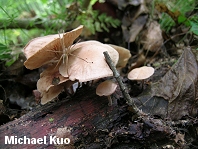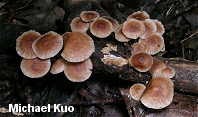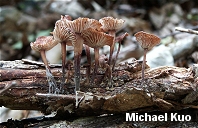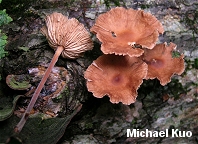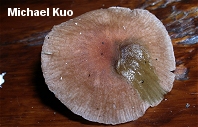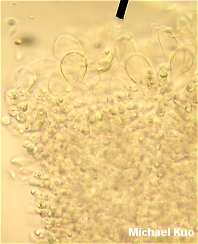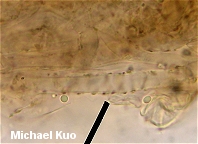| Major Groups > Gilled Mushrooms > Pale-Spored > Collybioid > Gymnopus dichrous |

|
Gymnopus dichrous [ Basidiomycetes > Agaricales > Marasmiaceae > Gymnopus . . . ] by Michael Kuo Gymnopus dichrous is a tough little wood decomposer, frequently found on hardwood sticks and logs from the Great Plains eastward. In dry weather it can shrivel up and become inconspicuous--only to revive when the rain returns. I have seen specimens last for months using this strategy, eventually becoming tattered and contorted. Gymnopus subnudus is a very similar species that grows on leaf littler rather than wood; it also differs microscopically. Collybia dichrous is a synonym. Description: Ecology: Saprobic; growing scattered, gregariously or in loose clusters on sticks, logs, and stumps of oaks, beech, and other hardwoods; late spring through fall; widely distributed east of the Rocky Mountains. Cap: 1-5 (rarely 7) cm; convex with an incurved margin when young, becoming broadly convex, flat, or shallowly depressed; dry; fairly bald; brown to reddish brown or orangish brown at first, fading to pinkish tan or buff; usually becoming somewhat radially wrinkled and developing a broadly lined margin; in old age or in dry conditions often splitting radially and/or becoming contorted. Gills: Narrowly attached to the stem, or nearly free from it by maturity; close or nearly distant; whitish when young, darkening to pinkish buff; sometimes stained and spotted reddish brown when old. Stem: 1-5 cm long; up to about 5 mm thick; more or less equal; dry; tough; finely hairy or finely velvety; buff above, but colored like the cap or darker below; with a very slight, fuzzy, swollen knob at the point of attachment to the wood. Flesh: Whitish to brownish; thin; tough. Odor and Taste: Not distinctive. Chemical Reactions: KOH olive on cap surface. Spore Print: Creamy white. Microscopic Features: Spores: 10-12 x 3-4.5 µ; smooth; lacrymoid to elliptical; inamyloid. Pleurocystidia absent. Cheilocystidia usually abundant, but soon collapsing and often difficult to differentiate (sometimes requiring several mounts); often swollen; saccate to fusoid-ventricose; occasionally somewhat lobed and/or diverticulate; to about 60 x 25 µ. Pileipellis a tangled cutis of cylindric elements 3-11 µ wide, frequently encrusted (in bands or spirals) with brownish pigment in KOH, with occasional "thumbs" and branchlets. REFERENCES: (Berkeley & M. A. Curtis, 1853) Halling, 1997. (Saccardo, 1887; Halling, 1983; Halling, 2004; McNeil, 2006.) Herb. Kuo 06100303, 06100304, 07140305, 07220311, 05290403, 06031005, 09081201. This website contains no information about the edibility or toxicity of mushrooms. |
© MushroomExpert.Com |
|
Cite this page as: Kuo, M. (2013, January). Gymnopus dichrous. Retrieved from the MushroomExpert.Com Web site: http://www.mushroomexpert.com/gymnopus_dichrous.html |
